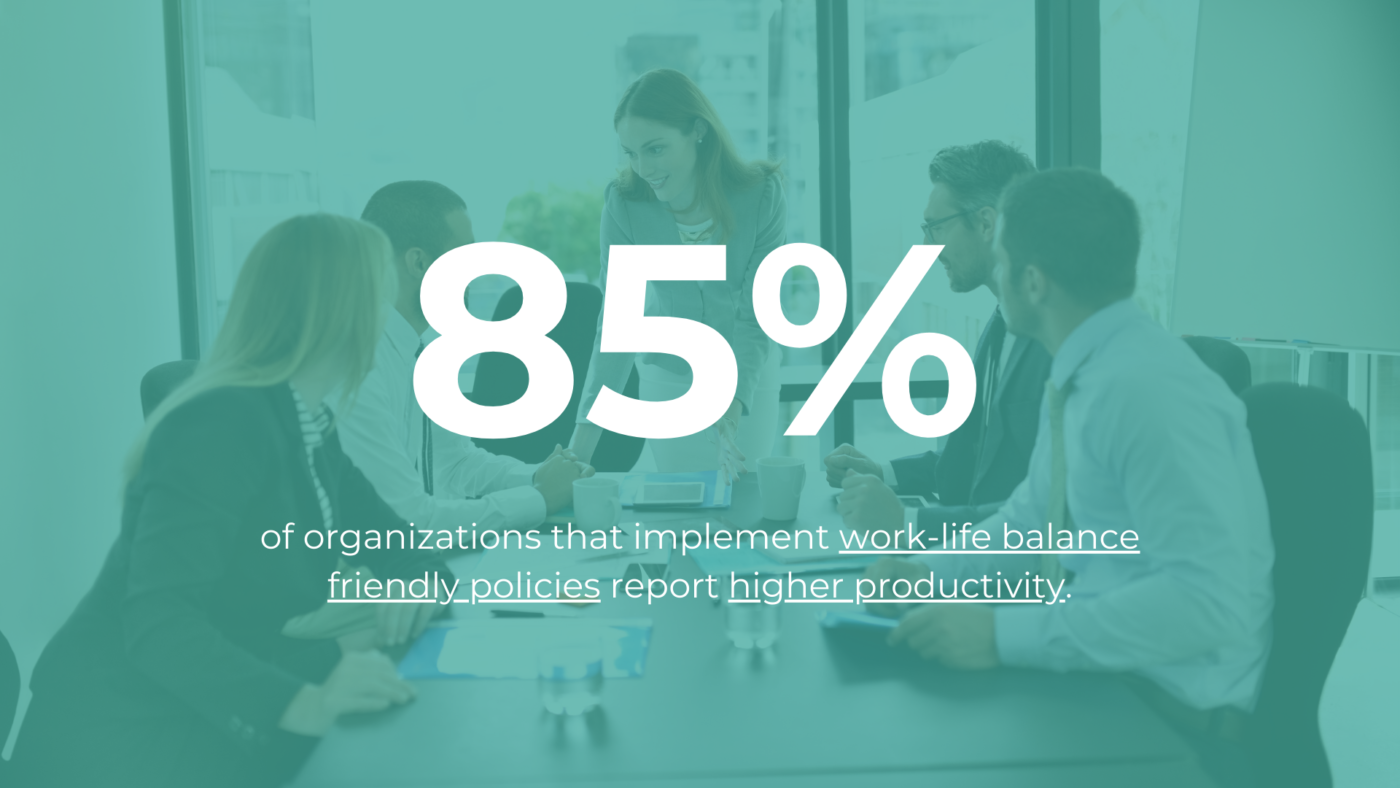Are you a new mom and 9-5er? Then you may have heard about work-life balance and desperately wanted to ask your mom colleagues what they were talking about, but couldn’t bring yourself to raise your hand.
I get it. In the leadership community, we all want our teams to be healthy, happy, fulfilled, and most of all, productive.
Today, you’re in luck because I’m going to show you everything you need to know about work-life balance for working moms but were afraid to ask—including how to differentiate it from its false friend named self-care.
You’ll be ready for your first day back at work after maternity leave.
What is Work-Life Balance?
I’m not here to bury the lead; in simple terms, work-life balance means the ability to balance work and personal responsibilities while still having time for leisure—and this describes a seemingly unobtainable standard for working moms. More on that in a minute.
Work-life balance aims to help people avoid overwhelm and burnout, increase productivity, and maintain physical and emotional health. It also helps people maintain social connections.
Feeling overwhelmed and want to know how to start using work-life balance to your best advantage?
Take the Overwhelm Culprit™️ Quiz for free today and learn where to start!
Why is Work-Life Balance Important?
You may come across leaders who believe an organization’s success is directly related to how much time their team spends in the office. However, post-pandemic return-to-office mandates have spelled disaster for working mothers.
In 2022, 65.6% of women worked full-time year-round—the highest percentage ever on record. By 2023, when return-to-office mandates began, we saw 18% of working mothers leave their jobs due to workplace inflexibility and the cost of child care. These are signs they couldn’t find the work-life balance necessary to continue being both caregivers and high-performers in a 9-5 office environment.
When you prioritize work-life balance, advocate for it in your organization, and maintain the flexibility you need, you can care for your family and yourself while staying productive at work.

As a bonus, 85% of organizations that implement work-life balance-friendly policies report higher productivity.
For example, Netflix is famous for its unlimited PTO policy and focus on parental leave. They believe balance is so important that they pay employees to take time off, knowing it will pay off for the company in the long run.
The History of Work-Life Balance
Don’t worry—this isn’t some boring history class.
To understand a misunderstood concept, it helps to know where it comes from. For work-life balance, we look back at the manufacturing laws of the late 1800s.
Laws preventing women and children from working in factories eventually led to the 1938 Fair Labor Standards Act, which established a 44-hour work week. In the 1980s, the Women’s Liberation Movement brought work-life balance back into the conversation, as women began holding down careers while managing their families and homes.
Want to dive deeper into this history? Check out this article from the National Library of Medicine.
How Work-Life Balance Works
We’ve been pretty theoretical so far. If you’re as annoyed as I was that work-life balance gets passed off as a solution to a systematic issue, I don’t blame you.
When I first started learning about it, I thought it was an impossible solution. But as a working mom of four in two different school districts, balancing family priorities and career success (TEDx speaker, Fortune 500 speaker, and soon-to-be author), I was wrong.
Luckily, work-life balance is easier in practice than it sounds in theory. Here are a few strategies to help you balance work and life.
Example #1: Prioritizing Self-Care to Increase Productivity
I first applied work-life balance as a Senior VP and single mom. My 50-hour work week and 20-hour commute left me too exhausted to be present for my son. I thought, “I’m giving all my time to others and none to myself.”
For me, self-care was my parents taking my son so I could enjoy an evening alone.
You need to regularly devote time to yourself and find activities that fill your cup. This mental recharge is necessary to stay present, creative, and productive.
Want self-care ideas specifically for working moms? You’re in luck—grab my Self-Care Handbook for Working Moms here.
Example #2: Creating a Flexible Routine Based on Energy Levels
High-performers often match their tasks with their energy levels.
Here’s how you can do it:
- List your daily responsibilities (work and home).
- Assign each task an energy requirement.
- Track your energy levels over the day.
- Plan tasks that match your energy levels.
For example, I’m most focused in the morning, so I schedule high-priority work after dropping my kids off at school. I save lower-energy tasks, like answering emails, for the afternoon when interruptions are more likely.

Example #3: Setting Non-Negotiable Family Time
This is where boundaries come in.
For example, turn off your work notifications when you clock out. Here’s how to set boundaries:
- Set clear hours and responsibilities at work and home.
- Communicate your boundaries with your boss, colleagues, and family.
- Stick to the boundaries you’ve set.
As a business owner, I used to struggle with checking emails and social media after hours. My husband wasn’t thrilled! I bought this device (it looks like a fridge magnet) that limits my phone’s functionality on weekends, so I can focus on my family. Come Monday, I scan it, and I’m back to work!

I hope work-life balance for working moms is clearer now.
One reason I started Corrie Lo & Co was to help women become confident leaders and implement work-life balance policies from the top down. Our kids’ generation deserves workplaces that support them.
Still have questions? Find me on LinkedIn, Instagram, Facebook, Twitter (X), YouTube, and TikTok.
Want to get started now? Take my free Overwhelm Culprit™️ Quiz to find out what’s holding you back.

